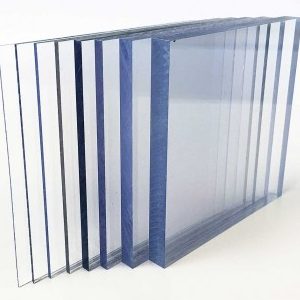Chapter 26 of the International Building Code (IBC) addresses the use of plastics in building construction and components. Section 2606 of the IBC classifies polycarbonate as a Light Transmitting Plastic and prescribes the requirements for its use in various configurations such as walls, roof panels, skylights, signs and glazing. Section 2604 provides direction for plastics used as Interior Finish and Trim.
Light Transmitting Plastics
- Shall have a self ignition temperature of 650 F (343 C) or greater when tested in accordance with ASTM D1929.
- Shall have a smoke development index of not greater than 450 when tested in the manner intended for use in accordance with ASTM E-84 or UL.723, or an average maximum smoke density rating not greater than 75 where tested in the thickness intended for use in accordance with ASTM D2843.
- Shall conform to one of the following combustibility classifications:
- Class CC1 : Plastic materials that have a burning extent of 1 inch (25 mm) or less when tested at a nominal thickness of 0.060 inch (1.5 mm), or in the thickness intended for use in accordance with ASTM D635
- Class CC2 : Plastic materials that have a burning rate of 2.5 inches per minute (1.06 mm/s) or less when tested at a nominal thickness of 0.060 inch (1.5 mm), or in the thickness intended for use in accordance with ASTM D635.
Typically, polycarbonate will meet the requirements of a Class CC1 material.
Interior Finish and Trim
Plastic materials installed as interior finish or trim shall comply with Chapter 8 of the IBC. This chapter contains the performance requirements for controlling fire growth and smoke propagation within buildings by restricting interior finish and decorative materials. The provisions of this chapter require materials to meet certain flame spread or flame propagation criteria and smoke developed criteria based on the relative fire hazard associated with the occupancy.
Interior wall and ceiling finish materials are required to comply with the requirements of NFPA 286 or ASTM E-84 or UL723.
NFPA 286
- During the 40 kW exposure, flames shall not spread to the ceiling.
- The flame shall not spread to the outer extremity of the sample on any wall or ceiling.
- Flashover, as defined in NFPA.286, shall not occur.
- The peak heat release rate throughout the test shall not exceed 800 kW.
- The total smoke released throughout the rest shall not exceed 1,000 m2.
Materials complying with NFPA 286 shall be considered to also comply with the Class A requirements of ASTM E-84 or UL723.
ASTM E-84 or UL723
Materials tested to these test standards shall be grouped in the following classes based upon their flame spread and smoke development indices:
- Class A : Flame spread index 0 – 25; smoke developed index 0 – 450
- Class B : Flame spread index 26 – 75; smoke developed index 0 – 450
- Class C: Flame spread index 76 – 200; smoke developed index 0 – 450
In accordance with Section 803.2 of the IBC materials having a thickness of less than 0.036 inch (0.9 mm) applied directly to the surface of walls or ceilings shall not require to be tested.
Various grades of polycarbonate have been shown to meet the requirements of NFPA 286.
ASTM E84 or UL723 (also known as the Steiner Tunnel tests) were not originally developed to evaluate plastics. Polycarbonates exhibit mixed results when tested in accordance with these test methods. Polycarbonate tends to produce flaming droplets when an ignition source is applied to the edge. These flaming droplets may fall off the edge of the material causing it to no longer burn. The phenomenon is typically seen in the thinner samples. Polycarbonate exhibits a black smoke when burned and the smoke indices are measured optically. Some polycarbonates that continue to burn typically fail the smoke index criteria. This is typically seen in the thicker samples.
There are polycarbonates that meet the ASTM E-84 / UL.723 criteria under the various classes. It is important to note that there are many factors involved in interior finish applications: building occupancy classifications, location limitations, exceptions with the use of sprinkler and fire suppression systems that may allow the use of polycarbonate in these applications.
For additional building code inquires regarding occupancy restrictions, area limitations, separation requirements, and sprinkler allowances for polycarbonate used in light diffusing systems, electric luminaries, solar collectors, glazing, skylights, interior signs, roof panels and interior finish, please contact Liz Grimes – Technical Director. Tel: 215.872.3532 Email: LGrimes@highlinepc.com

